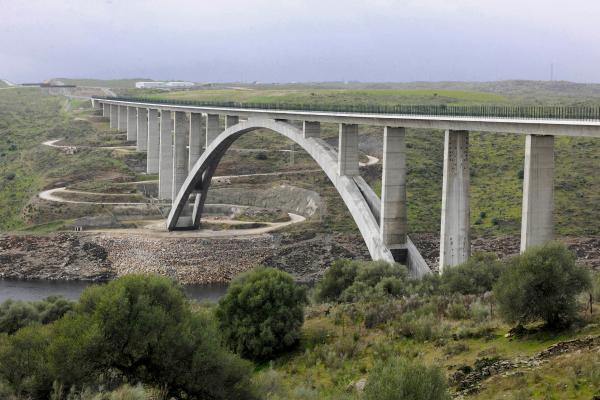
- The EIB will finance the 282 km connection between Talayuela (on the border between the Autonomous Communities of Extremadura and Castilla-La Mancha) and Badajoz (on the Portuguese border).
- The project is part of the Atlantic Corridor connecting the Iberian Peninsula with Central Europe.
- Employment impact: around 17 000 jobs will be created during the construction phase.
The European Investment Bank (EIB) will provide €890 million to Adif Alta Velocidad to finance the high-speed rail line connecting Madrid and Extremadura. This will help see the European Atlantic Corridor through to completion and significantly improve the connection between Spain and Portugal. The project is backed by the European Regional Development Fund and will receive Trans-European Transport Network (TEN-T) support.
The EIB and Adif Alta Velocidad have signed a €300 million loan agreement – the first tranche of a total of €890 million that the EIB will provide to develop this project.
More specifically, the EIB will finance the 282 km connection between Talayuela (on the border between the Autonomous Communities of Extremadura and Castilla-La Mancha) and Badajoz (on the Portuguese border), linking the cities of Navalmoral de la Mata, Plasencia, Cáceres, Mérida and Badajoz. The new high-speed line will be for mixed traffic (passengers and freight), and will significantly reduce journey times between the Spanish capital and Extremadura, a cohesion region that is home to over 1 million people. It will also greatly improve the connection between Spain and Portugal, facilitating interoperable and efficient freight connections to and from the south of Portugal.
The EIB financing will help reduce CO2 emissions, traffic and journey times between Spain and Portugal, benefiting more than 2.6 million passengers a year. At the same time, these investments will help boost the economic recovery following the COVID-19 crisis and will drive the employment of around 17 000 people during the construction phase.
EIB Vice-President Ricardo Mourinho Félix, who is responsible for the Bank’s operations in Spain, highlighted “the importance of TEN-T in connecting different European cities and countries, boosting economic activity, and improving people’s ability to travel between cities and countries. In addition, the development of low-emission infrastructure and means of transport is key to promoting the transition to a sustainable economic model – one of the other main priorities of the European Union and the EIB. That is why, as the European Union’s climate bank, we are pleased to be joining forces once again with Adif Alta Velocidad to finance investments in high-speed rail lines that will contribute to the creation of sustainable, high-quality employment in a cohesion region, to the recovery of the Spanish economy, and to the fight against climate change.”
According to Adif and Adif Alta Velocidad President Isabel Pardo de Vera, “the high-speed connection with Extremadura is one of the most important projects Adif Alta Velocidad is working on, as it will have a great impact across Spain, the Iberian Peninsula and Europe. The significant investment efforts required will help create jobs and enable economic, technological and regional development, which is even more important as the economy begins to recover in the wake of the COVID-19 crisis. Thanks to the EIB’s collaboration, we can continue to make progress in developing infrastructure that promotes regional cohesion, generates wealth and contributes to the fight against climate change.”
Since 1991, the EU bank has provided over €12 billion to promote high-speed rail in Spain, financing various projects including bringing high-speed trains to Seville, Barcelona, Valladolid, Burgos, Malaga, Córdoba, Alicante and Valencia. It is also financing the so-called “Y vasca” (the construction of a high-speed line between Vitoria, Bilbao and San Sebastián) and the Alicante-Murcia line.
The EIB and sustainable transport
The EIB has largely supported clean investment in rail and urban public transport in the past, in particular metro and tram projects, which contribute to the vast majority of climate action projects. The EIB’s investments in low-carbon transport (rail, metro, trams and alternative fuels) increased by 30% between 2018 and 2019 to €7.6 billion in 2019.
For more information on the EIB’s activities in the transport sector, read our overview of EIB investment in sustainable transport.
The EU climate bank
The EIB is the world’s largest multilateral provider of climate finance. Its goal is to be a leader in mobilising the finance needed to limit the average global temperature increase to 1.5°C compared to pre-industrial levels in order to meet the Paris Agreement objectives. On 14 November 2019, the EIB Board of Directors approved its new climate objectives and the new energy lending policy. The Bank will gradually increase its financing for climate and environmental objectives up to 50% by 2025, with the goal of ensuring that the EIB Group mobilises at least €1 trillion in the critical decade between 2021 and 2030 to promote investments helping to meet these objectives. It also announced its intention to align all EIB Group activities with the Paris Agreement. To this end, the EIB will cease financing fossil fuel-based projects from late 2021.
The EIB is the world’s largest issuer of green bonds and was the first organisation to make an issue on this market in 2007.
Adif – Alta Velocidad is a state-owned company under the Spanish Ministry of Transport, Mobility and Urban Agenda. It plays a leading role in promoting the railway sector, working to make rail the top means of transport and facilitating equal access to such infrastructure.

